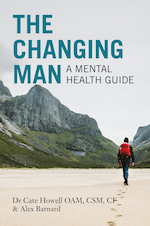Did you know that suicide rates in men are three times higher than for women, and are a leading cause of death in young men globally?
Just like women, men experience a range of mental health issues, such as stress, depression, anxiety, schizophrenia, substance-related issues, autism and post-traumatic stress disorder.
However, men are less likely than women to seek help for mental health issues, and they may delay or avoid getting help. But there are many things that you can do to help the men in your life reach out and access some assistance, and to work towards recovery and wellbeing.
Here are seven key strategies to help men towards better mental health.
1. Understand the impact of masculinity on mental health
To help understand men’s mental health, it is useful to explore what it is to be a man. Men are socialised to suppress emotion, and to be “strong”, no matter how they are feeling. In addition, men naturally want to be “one of the boys” and they innately compare themselves to other males.
Think about the statement “to man up”. It implies being tough and hard. When men believe that they are being “weak” or not measuring up to other men, they can feel a sense of shame. Shame is a feeling stemming from unhelpful thoughts or beliefs, such as “I am deficient (or) bad” in some way.
Women can struggle to deal with men expressing their vulnerability as they too are socialised to expect a man to be “strong” and riding high on that “white horse”. So it is important that, as women, we become aware of this issue and perhaps change our old beliefs about masculinity and give men space to speak about it.
2. Be aware of how mental health issues might become apparent
Mental health issues may reveal themselves in a number of ways, some not so obvious. These include:
- Physical symptoms such as disturbed sleep or tiredness.
- Emotional symptoms such as low mood or anxious feelings.
- Cognitive symptoms such as poor concentration or memory, or pessimistic thinking.
- Behavioural issues such as withdrawing socially, struggling at work, irritability and anger, or addictions.
3. Understand why men find it hard to seek help
There are a number of potential barriers that stop men from seeking help. The general stigma that still exists in the community about mental health issues does not help. And experiencing any emotional issues or seeking help might be perceived as being “weak”, “not in control” or being vulnerable, and may trigger shame.
In addition, men seem to have greater difficulty in recognising emotions than women, not only because of how they have been taught to push feelings down when growing up, but also because they may experience emotions in different ways. Men are more likely to notice the physical symptoms of emotional distress before the emotional ones, so they may not realise that their mental health is suffering.
When a man recognises that there is a problem, he may decide to get help, but when he reaches out, he may feel very uncomfortable talking about his mental health. He may say “no” to the help that is offered because of all of the reasons mentioned above. It is important to be patient and supportive.
4. Know how to help a man to reach out
Here are some suggestions:
- Don’t expect men to readily talk about their feelings.
- Sit down and talk side-by-side rather than face-to-face.
- Maybe talk in the garden or on a walk outside.
- Help the man identify any problems or physical signs of mental health issues (such as problems with sleep or fatigue).
- Focus on actions that can help (such as regular exercise, taking some time out to relax and getting a check-up).
- Listen and offer support.
- Talk about reaching out for some assistance as a sign of strength and courage.
- Provide some information about mental health issues, such as from our book, The Changing Man, Mental Health First Aid Australia, Mensline Australia, Beyond Blue, or Man Alive.
- Know where men can access support (such as your GP or the places mentioned above) and who to contact in an emergency (such as your GP, Mental Health Triage 131465, police or ambulance).
5. Utilise practical tools to help with mental health issues
In The Changing Man, we talk about 12 key tools to help men identify and take action on any mental health issue that they may be experiencing. The aim is to build up a toolkit over time to help manage any issues.
The 12 key tools are:
- Identify the key issue(s) (such as stress, grief, anxiety, addiction . . .).
- Set some goals: These need to be achievable and tackled in small steps.
- See your doctor and have a check-up: This is vital as some underlying physical health issues can trigger mental health issues.
- Focus on your lifestyle (such as healthy nutrition, moderate alcohol use, regular exercise, good quality sleep, regular relaxation . . .)
- Gather information about your issue(s).
- Reach out to others (a partner, mate, GP, counsellor . . .).
- Consider counselling or talking therapies (such as counsellor, psychologist, men’s group).
- Utilise your work and other meaningful activities.
- Consider complementary therapies (such as supplements).
- Work on prevention.
- Consider whether medication has a role (talk with your doctor regarding this).
- Practise and more practise!
6. Learn about anger management
In our society, anger is one of the only acceptable emotions for males to show. It can be a normal, healthy reaction to feeling threatened and can follow on from feeling scared, sad, hurt, insecure or lonely. It has been reported that more men in Western countries are presenting to therapists because of anger issues.
Men’s roles and work options are changing in life, and this is said to be a contributor to anger. Anger can also be an issue when there is co-existing depression or substance use.
Other factors that can contribute to men feeling angry are stress, frustration, being tired, hungry or in pain, grief or physical withdrawal from certain drugs. Anger changes the brain function so that it can be hard to make good decisions when feeling angry.
Anger can range from feeling frustrated or annoyed to full-blown rage. Anger becomes a problem when it impacts negatively on relationships, work, health or causes issues with the law. Signs that anger is a problem include:
- feeling angry a lot of the time,
- others being worried about the anger,
- the anger leading to problems with relationships or work,
- anger being out of proportion to the triggering event(s) or lasting a long time,
- or when it is triggering depression or substance use issues.
Understanding anger, identifying related feelings such as hurt or depression, identifying early warning signs of anger (such as muscle tension), working on helpful ways to express anger, taking responsibility for anger and getting some help from a therapist can all assist.
Anger or rage can involve verbal, emotional, physical or psychological abuse (domestic violence). Unacceptable behaviours by anyone need to be addressed as a matter of priority and urgency.
If you have experienced sexual assault, domestic or family violence, contact 1800RESPECT (Australia) | It’s Not OK (New Zealand)
7. Invest in prevention
Prevention is about stopping something from happening and, in terms of mental health, it is about preventing the occurrence of an issue in the first place or preventing it from worsening or recurring. And if it is a long-lasting issue, then learning to manage it, and having the best quality of life possible.
Many of the tools in The Changing Man aim to help the man develop coping skills, improve the current circumstances in your life, and prevent issues from occurring in the first place or from relapsing. All of the tools are ultimately related to prevention; and many of the tools discussed in the book have the bonus of building resilience, which refers to adapting to stress and change in life.
Part of prevention is having the tools to improve emotional intelligence, that is, having the words for, and an understanding of, emotion. Tools that can help include:
- Being aware of the sensations in the body related to the emotion (for example, anger might trigger muscle tension, or sadness might be felt in the chest). Naming the feelings or putting words to them.
- Knowing that expressing feelings is a learnt behaviour, so practise is needed to get good at expressing feelings.
- Giving oneself permission to show some vulnerability.
- Learning to manage emotions, in particular how to soothe distressing emotions.
- Asking for help when needed.
Prevention also involves a lot of action:
- Stress management. Such as having some time out to relax, saying “no” to things some of the time, reducing workload or other demands.
- Working on developing more optimistic thinking. Humans are prone to negative thinking, and we often need to increase the number of positive thoughts. This may involve being less “black and white” in our thinking, or finding a way to turn negative thoughts around.
- Gratitude or identifying regularly what we are grateful for in life. It has been shown that once a week, talking or writing about a few things that you are grateful for, increased happiness.
- Put energy into what is important in life (based on values) and focus on these areas.
- Investing in relationships is a vital part of health and wellbeing, and ensuring there is strong connection and communication, and healthy conflict management.
- Practising being in the moment, on purpose and non-judgmentally, as it has a positive effect on mental health.
- Engaging in meaningful activities (such as time with family, work, sporting, social, creative or spiritual pursuits).
- Build self-belief and self-confidence by being less self-critical and more self-compassionate.
Support your man with hope
The quote by Einstein, “Learn from yesterday, live for today, and hope for tomorrow”, is a good way to finish the article. The quote acknowledges the fact we are all constantly learning (and in fact our brain is capable of change all through life), and it speaks to living for today and maybe focusing on what is important. It also includes hope, and this is vital in relation to men’s mental health.
Hope is part of being human, and it is not just wishful thinking. It involves taking some action to move towards change. The action may relate to developing more optimistic thinking, or a greater sense of self-belief, overcoming trauma or making changes at work. The action may include a supportive woman, encouraging a man to work on prevention, or to seek help and supporting him during recovery.

Dr Cate Howell and her son Alex Barnard’s new book The Changing Man is available now from Exisle Publishing and where books for better living are sold.
If you or someone you know needs help, contact:
Lifeline: 13 11 14 Australia | 0800 54 33 54 New Zealand
How helpful was this article?
Click on a star to rate it!
0 / 5. 0
Be the first to rate this post!
Dr Cate Howell & Alex Barnard
Related posts
Subscribe
Receive personalised articles from experts and wellness inspiration weekly!


